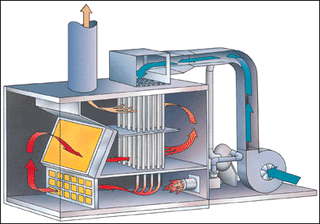
Catalytic Oxidizers
Catalytic oxidizers, also known as catalytic incinerators, are oxidation systems that control VOC and volatile HAP emissions. Catalytic oxidizers use a catalyst to promote the oxidation of VOCs to CO2 and water. The catalyst therefore allows oxidation to occur at lower temperatures than for thermal oxidation; catalytic oxidizers generally operate between 650°F and 1000°F.
Design factors for catalytic oxidation include temperature, residence time, turbulence or mixing of combustion air with the waste gas, VOC concentration and species, catalyst characteristics, and the presence of masking agents in the waste gas that can reduce the effectiveness of the catalyst bed.
To reduce fuel usage required for oxidation, catalytic oxidizers may have some form of heat recovery. The percentage of heat recovery in the design of catalytic oxidizers generally increases with decreasing inlet VOC/HAP concentration. Heat recovery may either be regenerative or recuperative. In regenerative heat recovery, hot exhaust gases and cool inlet gases are alternatively passed through a fixed bed, typically employing ceramics. In recuperative heat recovery, heat is recovered by passing the hot exhaust gases through a non-contact air-to-air heat exchanger to heat incoming air to the oxidizer.
Pacific Environmental Engineering Corp.
email pe@4voc.com